Abstract
The objective of this research paper was to establish the impact of e-marketing on consumers’ attitudes towards Emirates Airline’s products in the global arena. The research reviewed the perception of customers towards the airline’s e-marketing strategies and how they influence their attitude towards the products. The research was carried out through a primary research survey consisting of 200 randomly picked respondents.
The researcher used questionnaires that were mailed to respondents and collected after 4 days. The results indicated that there is a positive relationship between e-marketing and customer attitude towards the products being marketed by Emirates Airlines. From the analysis, there is a need for Emirates Airlines to invest more on appealing adverts to improve product intake, especially at the global market level. However, there is a need for further research involving a larger sample space to make scientific conclusions that can withstand tests in different regions and markets.
Introduction
It is important to review the impacts of e-marketing on purchasing behavior concerning customers of the Emirates Airline products. Since the beginning of the last decade, the Emirates Airline has quickly embraced the e-marketing strategies to be on par with other airlines within the global business arena. In the last two decades, e-marketing has played a key role in product promotion for the airline. The most common e-marketing platforms that the Emirates Airline uses include social media, the internet, and cable television. This paper will attempt to establish the actual impact of e-marketing on the attitude of customers towards the products of Emirates Airlines at a global level.
Significance of the study
Several studies have been carried out on the role that online marketing plays in increasing product sales within the airline industry. However, no such study has been done particularly focusing on how the e-marketing strategies should be intertwined with the consumer attitude to ensure effectiveness in promoting products and services at the global level. This paper extensively analyses primary data to illustrate how e-marketing influences consumer attitudes towards products of Emirates Airlines at a global level. The study is significant in establishing how different e-marketing strategies of Emirates Airlines should be modified to influence positive product intake across the globe.
Research problem statement
Emirates Airline has been strategic in consumer behavior analysis in a systematic manner using various consumer behavior models as impacted by how a product is marketed. For instance, the company has developed 360-degree feedback and consumer surveys to modify the products to meet the expectations of the customers. However, despite these efforts, there is a little result that has been achieved within millions of investments in e-marketing. Therefore, there is a need to establish a consumer attitude towards the products marketed by Emirates Airlines via e-marketing platforms to design effective adverts that might increase product acceptance and actual consumption at the global level.
Research question
The research question below was created to guide the focus of the study;
- What is the impact of the current Emirates Airline’s e-marketing strategies on consumer’s attitudes towards the company’s products in the global arena?
Research hypothesis
- H1o: The current e-marketing strategies by Emirates Airlines have an impact on consumer purchasing behavior across the international market.
- H1a: The current e-marketing strategies by Emirates Airlines do not have an impact on consumer purchasing behavior across the international market.
- H2o. There is a link between the level of product satisfaction and acceptance of the Emirates Airline’s e-marketing strategies.
- H2a. There is no link between the level of product satisfaction and acceptance of the Emirates Airline’s e-marketing strategies.
- H3o. Consumer attitude as influenced by the Emirates Airline’s e-marketing strategies is dependent on the level of trust and knowledge the customer has for the company itself.
- H3a. Consumer attitude as influenced by the Emirates Airline’s e-marketing strategies is not dependent on the level of trust and knowledge the customer has for the company itself.
Definition of terms
- Consumer attitude: The perception held by a consumer towards a product.
- E-marketing: Marketing strategies that are carried out via electronic platforms such as the internet.
Literature Review
According to a study carried out by Geld and Sundaram (2002) to establish factors that influence consumer behavior, the findings revealed that consumers are influenced by personal feelings and thought that include self-concept, motivation, attitudes, emotions, and perceptions. Through reviewing responses by 200 participants, the responses indicated that consumer behavior influences perception, purchasing patterns, and attitude customers develop towards a product or a service offered by the business.
In another study by Almana and Mirza (2013) to establish the best strategies for e-marketing, the findings revealed that wrong on inadequate approach might compromise the process, despite having great content and attractive design of the e-marketing platforms. The authors concluded that companies must start their online marketing strategy by focusing on attracting visitors. Therefore “before an organization can acquire customers through the content on its site, it must, of course, develop marketing communication strategies to attract visitors to the website” (Almana & Mirza, 2013, p. 26).
In another study by Gelb and Sundaram (2002) to examine the factors that might promote effective e-marketing strategies, the findings revealed that the quality of e-marketing determines the level of organizational performance and its competitive advantage at the local and international levels. At the same, time the internet marketer can analyze their online customers through the way they interact with the brand online since the electronic word of mouth has a direct influence on customer purchasing behavior (Gelb & Sundaram, 2002). Internet marketing communication in the form of the electronic word of mouth allows enterprises to reach out to the target market on a real-time basis.
In another study by Khammash and Griffiths (2011) to examine the external drivers influencing customer attitude towards an advertisement and the actual product, the findings confirmed that the use of e-marketing should be customized to appeal to different categories of customers. By reviewing the dependent variables of ego, ID, and superego and independent variable of personal orientation, with a sample space of 200 respondents, Khammash and Griffiths (2011) established that environmental stimulus is the driving force for a particular attitude of consumers towards an advertisement about a product. Since man is a cognitive being, Khammash and Griffiths (2011) concluded that the interpersonal stimulus events will be the primary and causative determinants of an overt purchasing behavior.
In a study by Malhotra and Agarwal (2004) to establish the factors that determine consumer loyalty towards a brand, the findings, through quantitative research, revealed that repertoire and subscription markets control customers’ loyalty to a brand. All the 250 respondents revealed that consumers’ repeated purchasing behavior is influenced by the ability of marketers to develop a middle action level between repertoire and subscription markets.
Reflectively, this aspect allows for insightful gain in customer loyalty behavior through appropriate electronic word of mouth marketing (Malhotra & Agarwal, 2004). Lastly, the study carried out by Rhim and Lee (2009) to establish how emotional appeal in the advertisement might influence actual consumer attitude towards a product, the findings revealed that emotional perspective of consumer behavior represents an effective view on consumer behavior in the form of attitudes. These attitudes are direct personal experiences that are influenced by consumers’ personality, advertisement, family, and friends.
From the above literature review, it is apparent that the existing research related to e-marketing effectiveness to how it appeals to customers reveals that emotions, level of trust, and perceived product quality. The current study is specifically on the impacts of e-marketing strategies that Emirates Airlines has adopted on customers’ attitudes towards the products marketed via electronic means.
Methodology
Participants
This research was conducted between March and April in the year 2016. A sample space of 200 participants was interviewed. The sample was chosen randomly across different ages, gender, and other social classes. The researcher used convenience sampling. The main reason behind the use of the convenience sampling technique is that it is not only cost-effective but also time-saving. In this approach, the researcher selected respondents based on their availability and convenience. To generate the sample size for this study population, the research adopted the formulae created in 1972 (Yin, 2003).
Sampling Formula
- n=N/ (1+N (e2))
Where:
- n = sample size;
- N= Target population;
- e= Degree of freedom;
- n=200/ (1+200*0.052);
- n=200/1.075;
- n= 187.907.
Materials
The research made use of primary sources of data collection through a questionnaire consisting of a total of twelve questions. The respondents were given questionnaires that had close-ended questions. In this research, all the questionnaires were sent to the 100 respondents, via email. Most of the target respondents have easy access to the internet. This was vital in determining the trends of internet marketing communication techniques in the form of e-marketing and its impact on consumers’ purchasing behavior. All the data from the field were relevant in attaining the goals of this research.
All these questions were sent to customers that engage in purchasing products over the internet. The main independent variable in this study was the e-marketing platforms used by Emirates Airlines. The dependent variable is the factors that influence customer attitude towards the airline’s products being marketing through e-marketing. The planning of these questionnaires was based on a five-point scale (Yin, 2003). The questions explored the views of the respondents about Emirates Airline’s e-marketing strategies, latest adverts, perceived level trust placed on these adverts, and how the adverts influence their attitude towards the company’s products.
Data collection procedures
The researcher emailed questionnaires to all the respondents and the filled questionnaire was mailed back after four days. All the data from the field were relevant in attaining the goals of this research. All these questions were sent to current and potential clients of Emirates Airlines who are aware of their e-marketing strategies. The researcher strongly believed that reality is made up of events and objects as they are understood and perceived in the consciousness of human beings. This means that nothing that does not rely on consciousness can be used by the researcher in defining reality (Yin, 2003). That is why the researcher made use of online customers to gather information on the impact of the current Emirates Airline’s e-marketing strategies on consumer’s attitudes towards the company’s products in the global arena.
Data analysis
The data analysis was made from the primary data which was collected through the questionnaires by the researcher. The collected data supports the aim of this research. The collected quantitative data was coded and passed through the Statistical Package for Social Sciences (SPSS) version seventeen. In the process, cross-tabulation was used to compare and contrast perception on the transition and the actual position of the same for customers of Emirates Airlines. To quantify the relationship between the independent and dependent variables, the analysis was essential besides figures, charts, and tabular representation of correlation analysis (Yin, 2003).
The collected data was presented through the charts and pie charts in chapter four data analysis. Analysis of variance focused on establishing the differences between the means of data collected from the targeted respondents. The analysis focused on the disintegrating the variation among and between groups. Therefore, the analysis attempted to establish if there exists statistical equality between the mean of the two groups of data. The first element of the analysis was that it measures the variations between groups. The second element was the variation within the responses (Yin, 2003).
Reliability and validity
Yin (2003) describes validity and reliability as determining the magnitude of accuracy in data collection during research. The aspect of validity is achieved by pre-testing the questions to be asked against the objectives of the research. The aspect of reliability examines the consistency in research instruments’ application and outcome generated. Since the research intends to apply these concepts in the process of carrying out a survey study, it is predicted that the findings are likely to “reflect the unique understanding that personal experiences bring to the development of case study” (Yin, 2003, p. 48).
The integration of direct interview and questionnaire balanced the competencies and practices in terms of relevance to the aim of the study (Yin, 2003). Before accepting the respondents to participate in the study, the research ensured that demographic and eligibility tests were rolled out to meet the present participation criteria (Yin, 2003). The questionnaires were sent to respondents via email by the researcher. For the questionnaires, the researcher used the online platform and collected them within four days to give the respondents enough time to answer the questions. The researcher included his contacts in the questionnaire to respond to any inquiry raised by the respondents in the shortest time possible (Yin, 2003). The researcher had to enhance the validity of this survey by pre-testing the questionnaires and correcting any inconsistencies within the questions. Primary data minimizes the possibility of any ambiguous data getting their way into the research. Primary data also assist in generating the empirical base of the survey (Yin, 2003).
Results
Demographic analysis of the sample
The following results of the study were obtained by analyzing the data.
Table 1-1 Characteristics of the sample (N=100).
200 respondents participated in this study in all, 50% of the participants are males and the rest of the participants are females. In terms of age distribution, we can notice that 25.6% of the respondents are under 21 years old, 27.1% of the respondents are in the 21-30 age, 24.1% of the respondents are in the 31–40 age, which almost has the same number of participants in 41-50 age, accounting for 23.2%. Besides from the table, it is apparent that the educational background of the participants, there are 29 participants completed the high school or below, accounting for 29.1% of the total samples.
Descriptive statistics
To check the correlation between e-marketing and consumer attitude, correlation analysis was carried out. The results are shown in table 4-4 below since the number of male and female respondents was equal. According to the results, the attitude towards the product is significantly related to e-marketing adverts, with a correlation of 0.381, and a significance value of 0.000, which is below 0.05 as summarized in the table below.
**. Correlation is significant at the 0.01 level (2-tailed).
Test of the Hypotheses
Hypothesis 1: The current e-marketing strategies by Emirates Airlines have an impact on consumer purchasing behavior across the international market: In this case, the various forms of relaying the e-marketing adverts were measured against the various indicators for consumer attitude towards the Emirates Airline’s products. The table presented below shows the data collected.
The data in the table above indicates that out of the sample of 200 people who were interviewed, the use of the e-marketing induced an intake of the Emirates Airline products for 106 people. Thus, it can be deduced that advertisement has a positive impact on consumer purchasing pattern. The information in the table above can be displayed in a histogram as shown below.
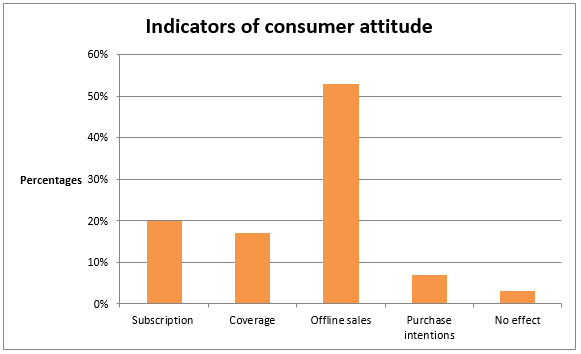
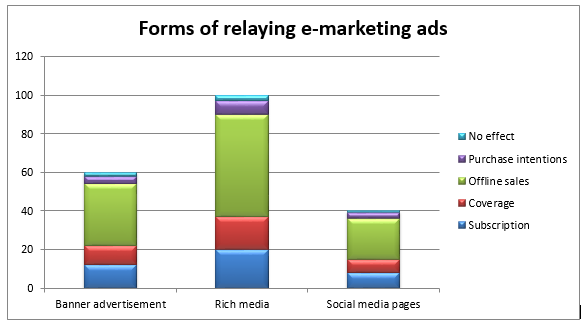
Hypothesis 2: There is a link between the level of product satisfaction and acceptance of the Emirates Airline’s e-marketing strategies: For this objective, a survey was conducted where customers were asked to give their opinion on whether e-marketing strategies increase the level of product satisfaction or not. The table presented below shows a summary of data based on the survey conducted.
Based on the data in the table above, 166 respondents (slightly agree, agree, and strongly agree) acknowledged that e-marketing advertisement increases the level of product visibility. 14 (neutral) were indifferent to whether e-marketing advertisement increases the level of product visibility or not. Thus, it can be concluded that there is a positive relationship between e-marketing advertisement and the level of product visibility.
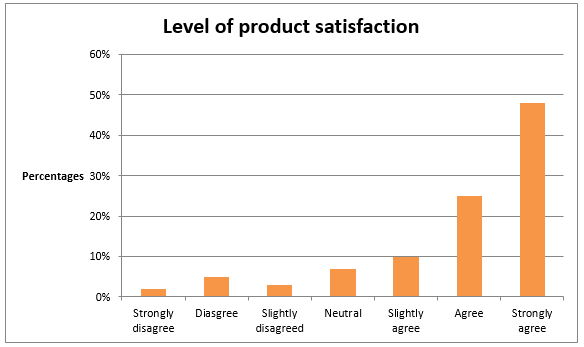
Hypothesis 3: Consumer attitude as influenced by the Emirates Airline’s e-marketing strategies is dependent on the level of trust and knowledge customer has for the company itself: In this case, the consumer purchasing behavior will be measured using volume sales while the level of trust and knowledge will be estimated using the Likert scale. Values will be attached to the Likert scale as presented below. The table presented below shows a summary of the data.
A correlation analysis will be carried out to determine the degree of association between the volume of sales and trust & the level of knowledge. A scatter plot diagram for the two variables is presented below.
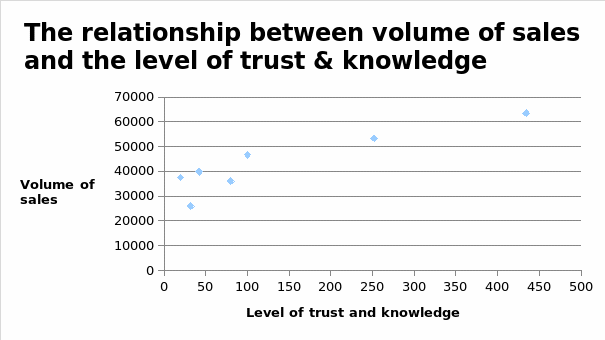
The points on the scatter diagram above tend to slope upwards. This indicates that the two points are positively related. The results of the correlation analysis are presented below.
The results of correlation show that there is a strong positive association between trust and the level of knowledge and volume of sales. A regression equation can be developed to estimate the relationship between the two variables. The results of the regression analysis are presented below.
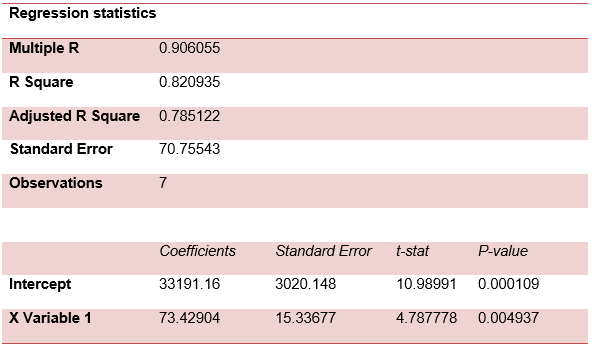
From the results in the table above, the regression equation can be written as Y = 33191.16 + 73.43X. The slope is positive and it shows that there is a positive relationship between consumer purchasing behavior and the level of trust and knowledge a customer has for a company. The value of the R – Square is 82.09%. It is favorable because it shows that level of trust and knowledge customer has for the company selling a product explains 82.09% of the variations in consumer purchasing behavior.
This shows a strong relationship between the variables. Further, the value of t – calculated (4.7878) is greater than the value of t-critical (1.96) at the 95 % level of significance. This implies that the explanatory variable is significant. In conclusion, the level of trust and knowledge customer has for the company selling a product has a strong positive influence on the consumer purchasing behavior, as influenced by the e-marketing strategies adopted by the Emirates Airline.
Discussion and recommendations
Discussions
From the above findings, it is apparent that the emotional perspective of consumer behavior represents an effective view on consumer behavior. Emotion is positively related to consumer attitude. This is the general evaluation that consumers engage in before deciding to purchase a product. Attitudes are direct personal experiences that are influenced by consumers’ personality, advertisement, family, and friends.
Perceptions are unique ways through which consumers internalize and interpret information about a product. This means that Emirates Airlines should utilize advertising materials such as electronic platforms to market different products and services since these behaviors have been proven to have a positive impact on consumers’ purchasing behavior. Given the literacy levels and the exposure to technological inventions of the target buyers, the group is likely to choose the products based on the psychological perception created by the electronic word of mouth advertisement.
For instance, as indicated in the findings, it is apparent that the probability p-value of the regression coefficient significance t-test is 0.003, which is less than the significance level ɑ (0.05), indicating that the linear relationship with the explanatory variables is significant. The regression coefficient was 0.334, which shows that when perception towards e-marketing advertisement increases by 1 point, the consumer attitude towards the product would improve by 0.334.
According to the results, product satisfaction, perception of quality, and awareness are significant and positively related to how e-commerce influences attitude towards a product, with a correlation value of 0.157 and significant at 0.05 levels. Since a correlation value below 0.3 represents a weak correlation, this result indicates that product satisfaction, perception of quality, and awareness have a weak correlation with-marketing strategies applied by the Emirates Airline. In other words, a better e-marketing approach will lead to higher-level product satisfaction as perceived by the customers. This means that all the hypotheses are accepted.
Limitation, Implications, and Future research
The primary limitation of the study was excessive concentration on external validity since the research assumed that the answers given by the respondents were accurate without carrying out any test to confirm the assumption. Besides, it is illogical to make a generalized conclusion from the sample space of 200 respondents as representing the current situation for all customers. Therefore, there is need to carry out further research on other factors that might impact the effectiveness of e-marketing strategies, rather than just the consumer attitude. Besides, it is important to expand the sample space during future research to draw more reliable findings and scientific conclusions that might be representational of the current situation at the local and global levels of Emirates Airline operations.
Recommendation
Since the research findings have revealed that e-marketing strategies influence customer attitude towards the products of the Emirates Airline, the marketers at the airline need to design more dynamic and appealing internet ads to attract more customers at local and international levels as part of strategies for increasing product uptake and acceptance across the globe.
Conclusion
The need for designing strategic and appealing online ads has increased in the airline industry. The study has presented an interesting insight into how consumer attitude towards Emirates Airline products is influenced by how e-marketing strategies are modeled. However, there is a need for further research to establish other insights that might influence the success of e-marketing strategies to expand the marketing knowledge and product presentation for the Emirates Airline in the dynamic global airline industry.
References
Almana, A., & Mirza. A. (2013). The impact of electronic word of mouth on consumers’ purchasing decision. International Journal of computer applications, 82(9), 23-30. Web.
Gelb, D., & Sundaram, S. (2002). Adapting to ‘word of mouse. Business Horizons, 45(4), 21–25. Web.
Khammash, M., & Griffiths, H. (2011). Electronic word-of-mouth (eWOM), antecedences and consequences, International Journal of Information Management, 31(3), 82-87. Web.
Malhotra, K., & Agarwal, J. (2004). Internet users’ information privacy concerns (IUIPC): The construct, the scale, and a causal model. Information Systems Research, 15(4), 336-355. Web.
Rhim, H., & Lee, C. (2009). Assessing potential threats to incumbent brands: New product positioning under price competition in a multi segmented markets. International Journal of Research in Marketing, 22(1), 159-182. Web.
Yin, R. (2003). Case study research: Design and methods. Beverly Hills, CA: Sage. Web.